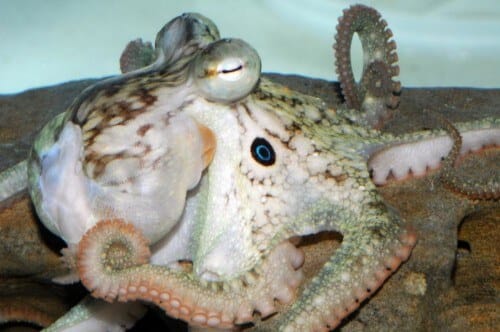Sequencing the genome also reveals prehistoric secrets from the evolutionary past of the family that includes the octopuses and squids, and whose representatives - the ammonites - once ruled the earth

An international team of researchers has completed the genome sequencing of a common species of octopus. In doing so, he brings the researchers closer to the discovery of the genes involved in the unusual biology of this creature, including its ability to change the color and texture of its skin, as well as its distributed mind that allows it to operate each of its eight arms separately, as well as to reach new insights about the Cephalopod group - the head and legs of the squid group, The squid and the octopus, or jet in the popular name, and which includes, in addition to the octopus, the squid and the cuttlefish.
The team members who sequenced and deciphered the genome of the two-spotted octopus (Octopus bimaculoides) - a common animal on the coast of California that is also used as an ornamental animal for aquariums - included researchers from the University of California at Berkeley, the Okinawa Institute of Science and the University of Chicago. The research was published on 13/8/15 in The journal Nature The project was initiated by Nobel laureate Sidney Brenner, founder and president of OIST.
The researchers discovered remarkable differences between the octopus genome and those of other invertebrates, including gene reorganization and a significant expansion of gene families responsible for nerve development that were once thought to be unique to invertebrates.
"The nervous system of the octopus is organized in a completely different way than ours. It has a central brain surrounding the esophagus, like the typical invertebrate brain but also groups of neurons in the arms that control arm movement. These small "brains" are relatively autonomous, but in addition they have large areas involved in the vision process. says Daniel Rokhsar), a professor of molecular biology and cell biology at Berkeley who led the research. "Sequencing the genome was an opportunity to examine the genome and see what we can say about this unique octopus brain pattern."
Understanding how the eight-armed octopus's distributed brains work could, for example, help engineers design flexible arms capable of grasping objects. In challenging environments such as underwater, such robots will be able to work better than rigid arms and legs.
intelligent invertebrate
With the help of large and distributed brains, squids are the most intelligent invertebrates that have been able to display problem-solving abilities and learning behavior," Roxar says.
"We have already discovered several types of genes that are expanded in the octopus compared to other invertebrates, and we believe that they play a significant role in a new level of neural complexity that can be reached in invertebrates," he said.
This includes a family of signaling molecules known as protocadherins that regulate nerve development and short-term communication between neurons, and a family of transcription factors known as zinc fingers, which are mainly expressed in embryos and nerve tissue and are believed to play a role in brain development."
"Decoding the octopus genome can help understand how prehistoric animals behaved, and better understand an important point in the tree of life for comparative evolutionary studies," says Clifton Ragsdale, professor of neurobiology and animal biology and anatomy at the University of Chicago. "The deciphered genome is a huge resource that opens up new questions for us that we might not have asked before about these impressive animals."
The first intelligent life on Earth
The prehistoric ancestor of octopuses, which is also shared by squids and neolithics (a type of sea snail), first appeared as a predator over 400 million years ago. Among the most successful creatures at that time were the ammonites which dominated the oceans during the Devonian period and whose fossils are very common in every excavation carried out today. They went extinct about 66 million years ago in the same mass extinction that wiped out the dinosaurs.
"These were the first intelligent beings on Earth" says Brenner. In the future, OIST plans to sequence several squid and octopus species from Okinawa, and Roxar hopes they will become a model for squid biology research.
The researchers also tracked the genes responsible for the octopus' color matching, which allows it to change its skin color and texture in order to blend in with its environment and escape predators.
"We discovered hundreds of new genes that do not have counterparts in any other animal and that may be involved in this unique camouflage process" says Roxar.
The deciphered genome could also help reveal the genetic basis for other innovations from the octopus, such as the sophisticated flapping of their arms and the suction rings used to detect chemicals in the water as well as to sense and grasp its food. Their ability to regenerate their arms in case of amputation, a propulsion system that allows them to fly in the water, camera-like eyes that are more like human eyes than the eyes of other invertebrates, and the fact that they have three hearts that keep the blood flowing through their gills.

One response
good